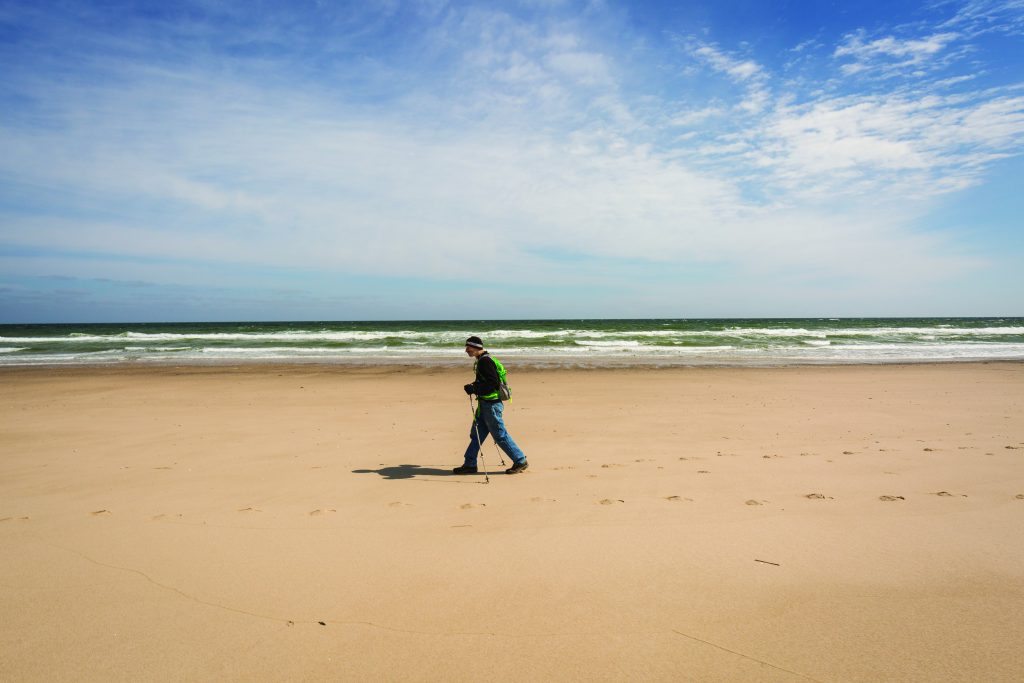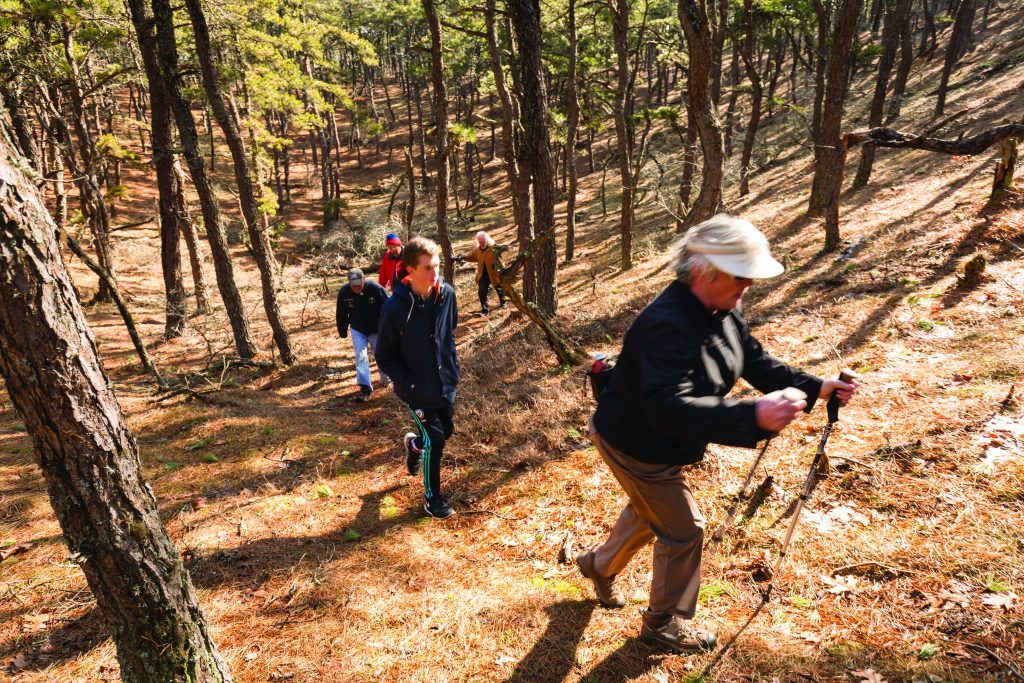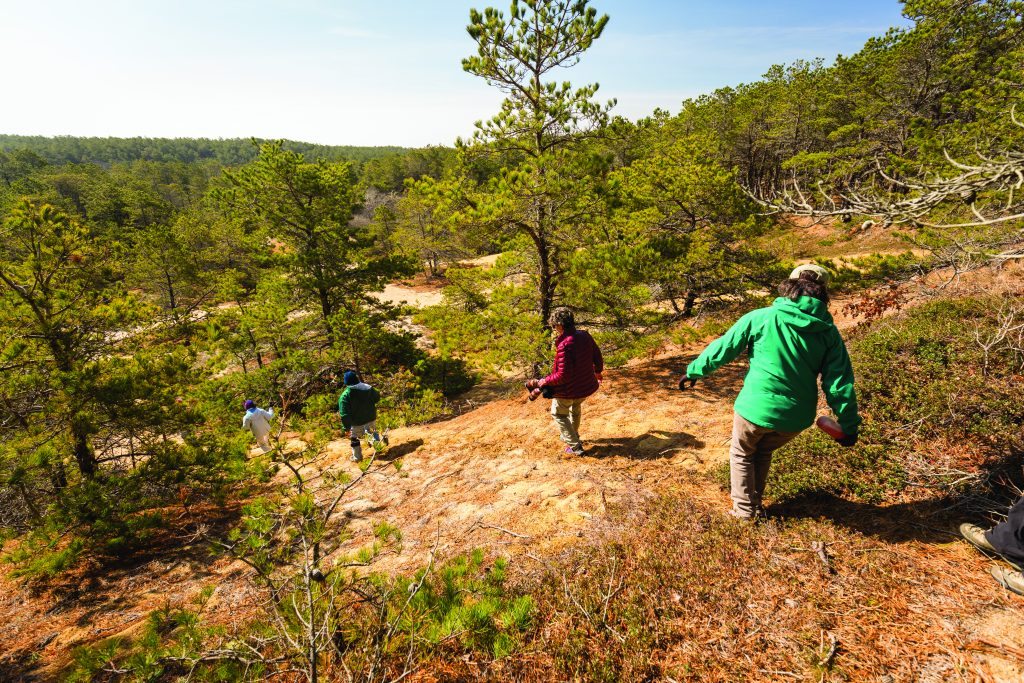
When the temperature drops, go take a hike!
Cape Cod Life / November/December 2015 / History, Nature, Recreation & Activities
Writer: Taylor Lange / Photographer: Dan Cutrona
When the temperature drops, go take a hike!

Cape Cod Life / November/December 2015 / History, Nature, Recreation & Activities
Writer: Taylor Lange / Photographer: Dan Cutrona
Details on five invigorating walks on the Cape & Islands

Photography by Dan Cutrona
The warm weather has come and gone, and the tourists and seasonal residents of summer have left the Cape and Islands a quieter place. Although winter may not be the ideal weather for a “beach day,” our region’s coastal settings offer those looking for outdoor activities plenty of options. For example, did you know there are numerous walking and hiking trails across the Cape and Islands that wind through wooded areas and along marshes and cliffs—all leading to spectacular ocean views?
In this article, we highlight five breathtaking hikes and walks: three on the Cape and one each on Martha’s Vineyard and Nantucket. Tis the season to lace up your boots, pack some snacks and a water bottle, and head out for a great day on the trail.

Photography by Dan Cutrona
Barnstable Great Marsh Wildlife Sanctuary
The Barnstable Great Marsh Wildlife Sanctuary offers 1.5 miles of interconnected trails through pristine marshland overlooking Barnstable Harbor. Tucked in the western end of the harbor, Great Marsh consists of 113 acres of marshlands, woods and beach, and boasts spectacular scenery. The marsh is connected to Sandy Neck, a 3,800-acre barrier beach ecosystem situated in both Barnstable and Sandwich.
“Great Marsh is an incredible place,” says Joshua Wrigley, education coordinator for Mass Audubon’s Long Pasture Wildlife Sanctuary. “It is part of a large area of undeveloped and beautiful shoreline.”
The marsh features five separate trails: Cedar Trail, Otter Trail, Sandy’s Trail, Cow Path, and Cooper Pond Loop. Wrigley, who coordinates programs for visitors including guided hikes of the marsh, which Mass Audubon oversees, says the area is an important ecosystem for many local species. The shallow water in the marsh helps keep larger fish and other predators away, making it a good nursery for young birds, fish, crabs and other crustaceans. (Continued on next page)
“It’s a great place to talk about how ecosystems function,” Wrigley says. “It’s a very resilient and vibrant marsh.” When the weather turns cold, Wrigley says walkers may spot numerous species of birds and owls as well as eiders, buffleheads and long–tailed ducks. One may also stumble across different species of marsh grass—low salt meadow cordgrass, and the taller smooth cordgrass. Another type of vegetation commonly found in the area is pickle weed; in fall, the weed changes from a bright green color to a striking deep red, mixed with orange and yellow.
Barnstable Great Marsh is located near 2444 Main Street (Route 6A) in Barnstable, across the street from the Barnstable/West Barnstable Elementary School. No sign marks the entrance to the sanctuary, but a driveway leads to a small parking lot for visitors. The trail is open year-round, from dawn to dusk, and trail maps are available at massaudubon.org.

Photography by Dan Cutrona
Marconi Station, Wellfleet
A short distance from Route 6 in Wellfleet, hikers and nature lovers will enjoy a brisk walk in the Marconi Station area, which is part of the Cape Cod National Seashore in Wellfleet.
“A particularly popular spot is the Marconi Station site,” says Susan Moynihan, the National Seashore’s chief of interpretation and cultural resources management and a 30-year veteran of the National Park Service. “One can stand on an overlook and see both Cape Cod Bay and the Atlantic.”
Named for Guglielmo Marconi, the Italian inventor who sent from this location the first transatlantic communication from the United States to England more than a century ago, the Marconi Site features scenic Marconi Beach and a system of trails, including the 1.5-mile White Cedar Swamp Trail. Considered fairly easy, the trail leads hikers through areas flush with tree varieties: from black and white oak and pitch pine to red maple and Atlantic white cedar.
A short walk from the parking lot, the overlook stands atop an 85-foot bluff running along the shore. With the leaves off the trees, the area offers long, gorgeous views of the coast. Visitors can look out over the ocean, where hundreds of ships over the years, including Black Sam Bellamy’s Whydah, have sunk or been washed ashore. Looking eastward, one can also view Cape Cod Bay.
“Nature as a powerful force and shaper of the Outer Cape could be considered another attraction in the winter,” says Moynihan, who adds that hikers should simply remain a safe distance from the cliff’s edge.
Most visitors can tour the site in about an hour. Maps and tourist and wildlife information, as well as restrooms, are available at the Cape Cod National Seashore’s headquarters, which is open year-round, Monday to Friday, at 99 Marconi Site Road in Wellfleet.

Photography by Dan Cutrona
Head of the Meadow Beach, Truro
Head of the Meadow Beach in Truro represents the epitome of a Cape Cod beach: it’s long, beautiful, sandy, and reaches out into the Atlantic. A popular spot in summer, the beach, which is part of the Cape Cod National Seashore, offers a different type of beauty in the off season; following a dusting of snow, for example, the 100-foot dunes resemble mountains.
“The National Seashore is open year round, weather permitting,” says Susan Moynihan of the Cape Cod National Seashore. “A heavy snow may close roads and parking areas but with enough snow some people enjoy cross-country skiing.”
The beach area also features a few recreational options for visitors: a two-mile bike trail and two hiking trails: (Continued on next page)
Small’s Swamp Trail and Pilgrim Spring Trail. The bike trail is flat, paved, and travels along the edge of a salt meadow, ending at Pilgrim Heights. The hiking trails are loops, each measuring about three-quarters of a mile and requiring about 30 minutes to complete. Both trails wind through scenic, forested areas and are not considered strenuous.
According to the National Park Service, the beach itself features three distinct geographical regions: a freshwater meadow, the outer beach, and pine uplands that culminate at the High Head bluff which offers great views of Provincetown. To the north of the area and at low tide, the shipwreck of the Frances, which sunk in a gale in December of 1872, can be seen from the beach.
“A lot of people like to visit in the winter,” Moynihan says. “Many people like to walk the beach or view the ocean waves from overlooks (during storms) to see wind and waves pummel the shoreline.”
Traveling north on Route 6, take the Cape Cod Light/Highland Road exit. Proceed one-quarter mile north, and you will see the Head of the Meadow Beach sign on the right. Once you turn right, it’s two miles to the beach. Maps of the trail system are available at nps.gov.

Photography by Dan Cutrona
Felix Neck Wildlife Sanctuary, Martha’s Vineyard
Felix Neck Wildlife Sanctuary consists of 194 acres of shoreline, marshland, woodlands and ponds as well as four miles of hiking trails managed by the Massachusetts Audubon Society. At 7/10ths of a mile, Marsh Trail is the longest of these and winds through a remote area of pitch pines and marsh. At the end of the trail, one can look out at Sarson Island.
“It’s a great walk for a lot of reasons,” Suzan Bellincampi, Mass Audubon’s director of the sanctuary, says of the trail system. “The trails are flat and they’re great for everyone.”
Throughout the winter—and the rest of the year—Mass Audubon offers guided tours of the property, leading walkers through a variety of habitats and shorelines. Visitors can also tour the property on their own and maps are available. Hikers at this time of year are likely to see ducks, deer, raccoons, and woodland birds such as Cedar Waxwings and Baltimore Orioles.
When the trails are covered in snow, Bellincampi says it’s not uncommon for visitors to use the trails for cross country skiing and snow shoeing—as well as hiking. “All around, it’s the perfect place to go,” Bellincampi says, “no matter what the season is.”
Located at 100 Felix Neck Drive in Edgartown, the nature center at the sanctuary is open year-round, Monday to Friday, from 9 a.m. to 4 p.m., and Saturdays, from 10 a.m. to 3 p.m.

Photography by Dan Cutrona
Shawkemo Hill Trail, Nantucket
Located off of Polpis Road, Shawkemo Hill Trail serves as a gateway to several walking paths that offer breathtaking views of unspoiled wilderness—as well as Nantucket Harbor. Overseen by the Nantucket Island Land Bank (NLB), the property offers a system of three trails accessible from an access point on Polpis Road. Traveling in the direction of Wauwinet, look for the NLB marker and parking lot just after North Pasture Lane.
Eric Savetsky, the land bank’s executive director, says the trails represent the influence of the last ice age on Nantucket’s topography. “The southern trail climbs to 94 feet and offers stunning views of the Middle Moors and Nantucket Harbor,” he says. “These hills are one example of the sediment deposits left behind after the Laurentide glacier receded approximately 18,000 years ago.”
According to nantucketlandbank.org, the Shawkemo Hill Trail offers a variety of topographies and scenic views and leads to additional trails and roadways in the magical Middle Moors. Notably, more than 6,000 years ago the area served as hunting grounds for the island’s native population, and a number of walkers in recent years have found arrowheads along the trails.
A resident of Boston, Hannah Pasman is a nature lover who grew up on Nantucket and is particularly nostalgic of the many hours she spent hiking throughout this wilderness area. “It’s a very special place,” she says of the Shawkemo Hill Trail. “Especially during the off season, when you might not find anyone else on the trails. It makes you appreciate nature even more.”
A native of Cummaquid, Taylor Lange is a freelancer writer and an avid recreational fisherman.



